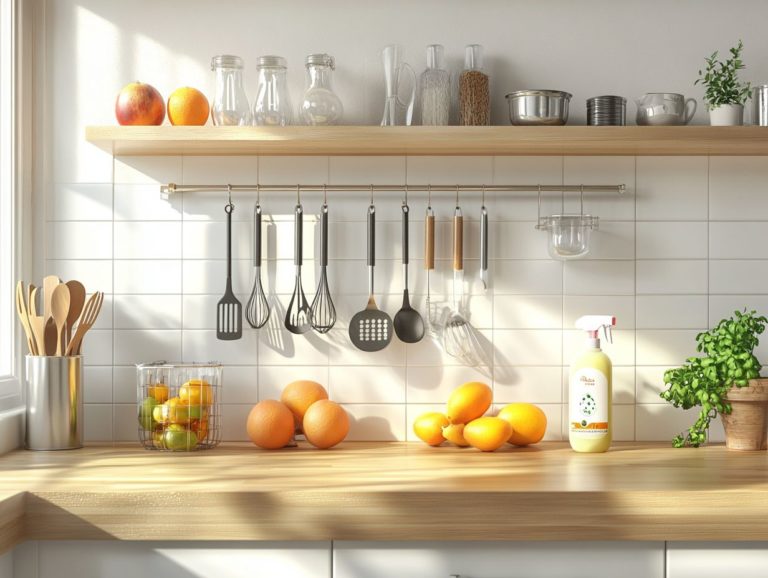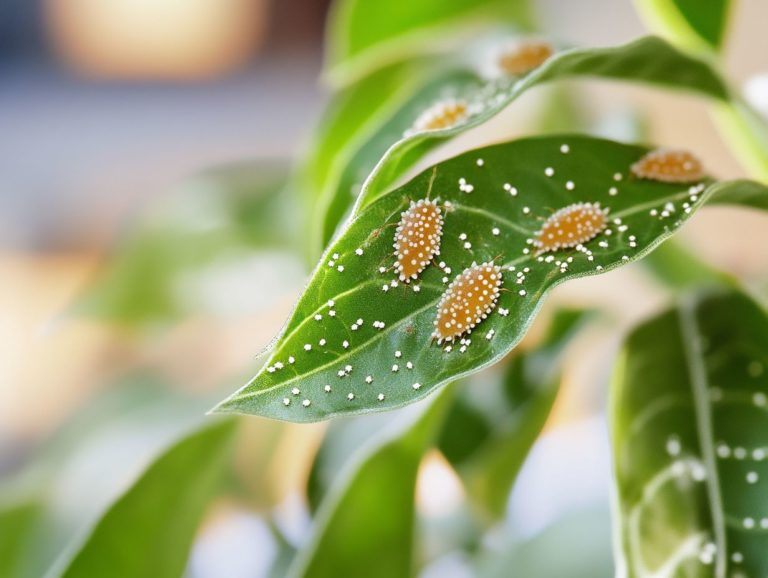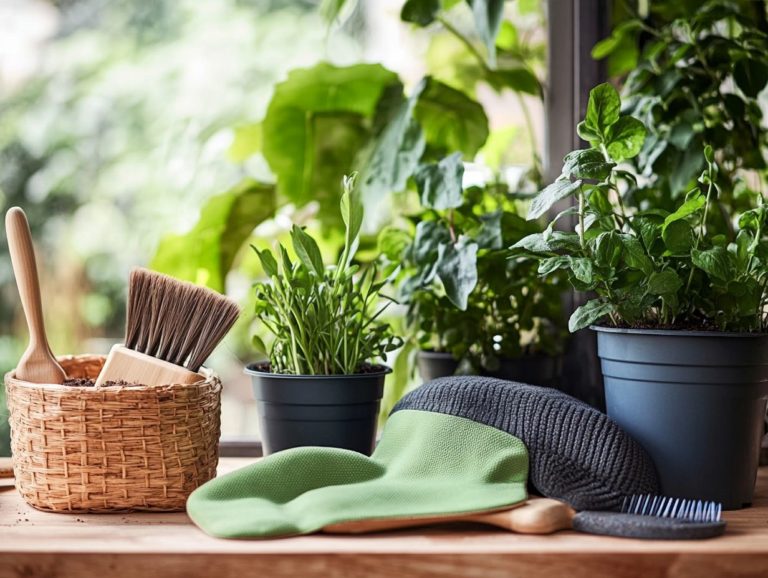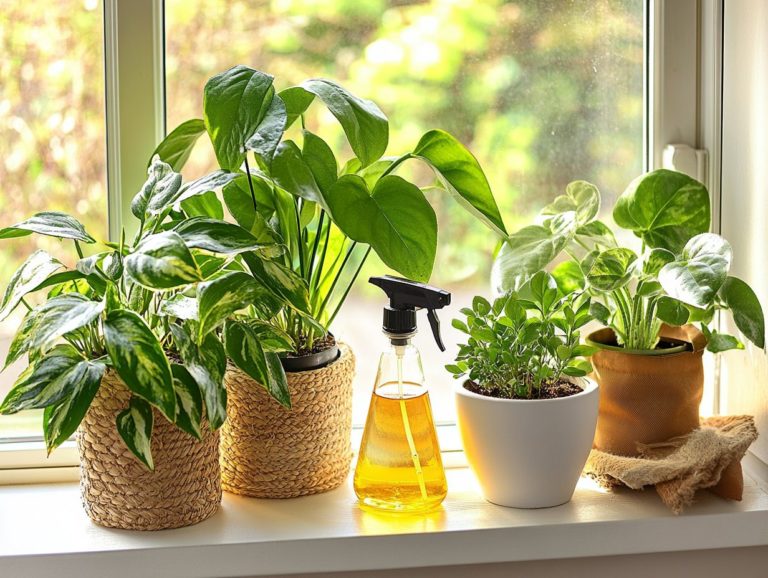5 Common Mistakes in Houseplant Care
Caring for houseplants and indoor plants can be an immensely rewarding endeavor. However, it often presents its share of challenges. Many plant enthusiasts may unwittingly stumble into common mistakes that can stifle their plants’ growth and overall health.
Get ready to discover the five biggest mistakes in houseplant care that could be holding you back from a vibrant indoor oasis! From the perils of overwatering to the pitfalls of insufficient light, these missteps can lead to wilted leaves and a lackluster indoor garden.
This article delves into the five most frequent pitfalls in houseplant care, providing you with practical tips to nurture a flourishing indoor oasis.
Contents
- Key Takeaways:
- 1. Overwatering
- 2. Underwatering
- 3. Lack of Proper Drainage
- 4. Not Enough Light
- 5. Overfertilizing
- How to Properly Care for Houseplants
- What Other Factors Can Affect Houseplant Care?
- Frequently Asked Questions
- What are the 5 common mistakes in houseplant care?
- How does overwatering affect houseplants?
- What happens if houseplants are not getting enough sunlight?
- Why is using the right type of soil important for houseplants?
- When should houseplants be repotted?
- What are some signs of underwatering in houseplants?
Key Takeaways:
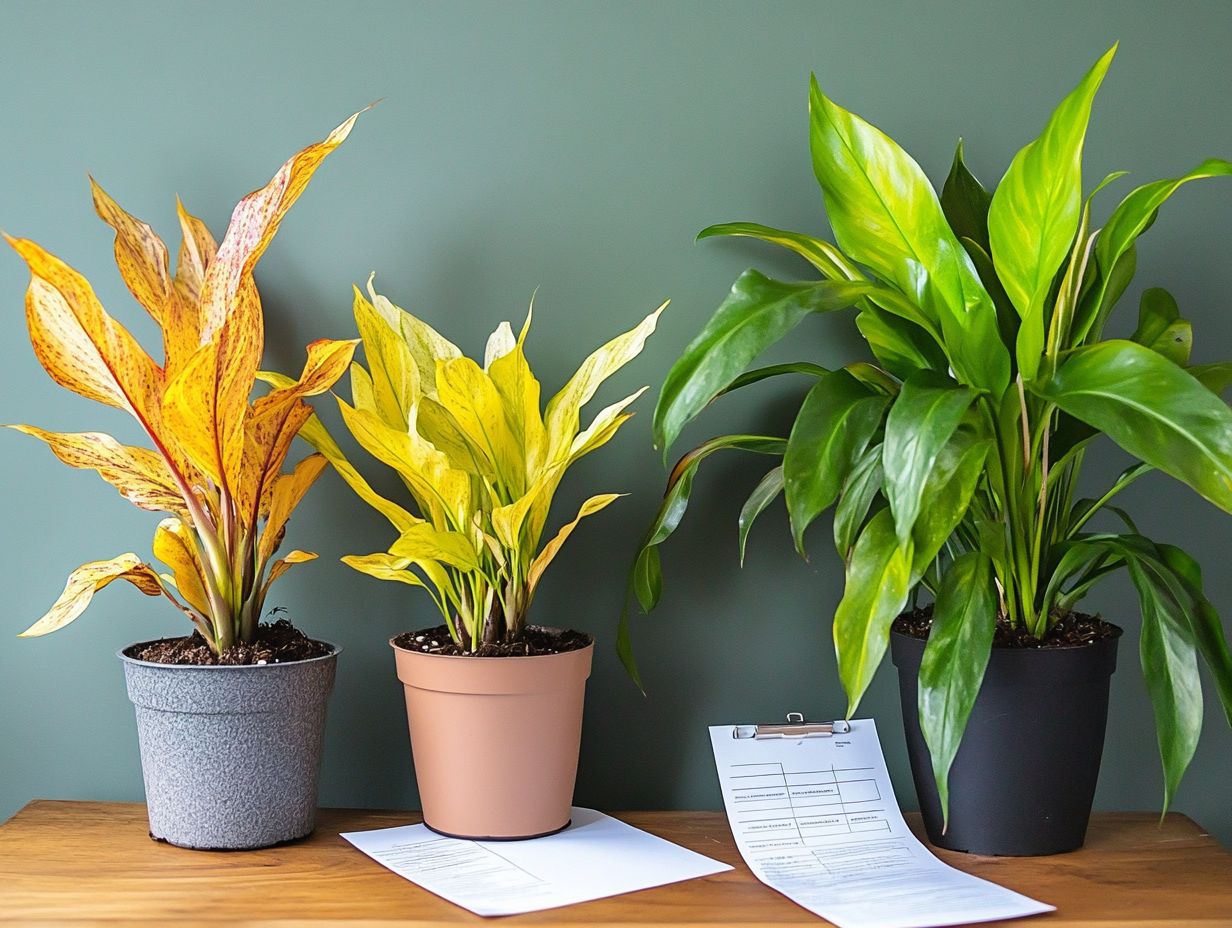
- Overwatering: This can lead to root rot. Watch for yellowing leaves and adjust your watering habits.
- Underwatering: This can cause wilting and stunted growth. Check the soil regularly and water when needed.
- Proper drainage is crucial. Ensure pots have drainage holes or use a well-draining potting mix to prevent waterlogging.
1. Overwatering
Overwatering is a common pitfall for plant parents. It can lead to issues like root rot and yellowing leaves, ultimately causing the decline of beloved houseplants.
To spot the signs of overwatering, keep an eye on your leaves. If you notice wilting or a shiny sheen, along with yellowing that indicates stress, it s time to reassess your watering habits.
Understanding how wet the soil is in your potting mix is essential; you want to avoid that soggy soil that lingers far too long. Adjusting your care routine based on the plant’s environment can significantly improve health. Factors like light, humidity, and temperature play a key role.
A timely tweak in your watering approach can bolster resilience and breathe new life into struggling plants. Ensure they thrive instead of just surviving.
2. Underwatering
Underwatering can be just as harmful as overwatering. It leads to wilting plants and stunted growth. As a dedicated plant parent, you must be in tune with your houseplants’ watering needs to maintain that perfect moisture balance.
You ll often notice signs of underwatering through dry, crumbly soil and leaves that droop or curl at the edges. To keep your plants thriving, establish a consistent watering schedule tailored to each species in your collection.
A helpful technique is to check the top inch of soil. If it feels dry, it s time to give your plants a drink, keeping in mind their specific watering needs. For added precision, consider using a moisture meter, and ensure your pots have drainage holes to prevent waterlogging.
Remember, achieving balance is essential. Monitoring conditions like temperature and humidity will guide your watering frequency, ultimately supporting robust growth in your beloved plants.
3. Lack of Proper Drainage
The absence of proper drainage can spell trouble for your plants. It can lead to issues like root rot and poor health. As a dedicated plant parent, it s crucial to select decorative containers equipped with adequate drainage holes.
These drainage holes play a critical role by allowing excess water to escape, preventing the soil from becoming waterlogged. Waterlogged soil can suffocate roots and create a breeding ground for unwanted bacteria and fungi, jeopardizing your plant’s health.
Choosing the right potting mix that promotes both soil aeration and moisture retention is just as vital. A well-balanced mix enables your roots to access oxygen while retaining enough moisture, ensuring your plants can efficiently absorb nutrients.
This relationship between drainage and potting materials greatly impacts your overall plant care. It sets the stage for a flourishing indoor or outdoor garden.
4. Not Enough Light
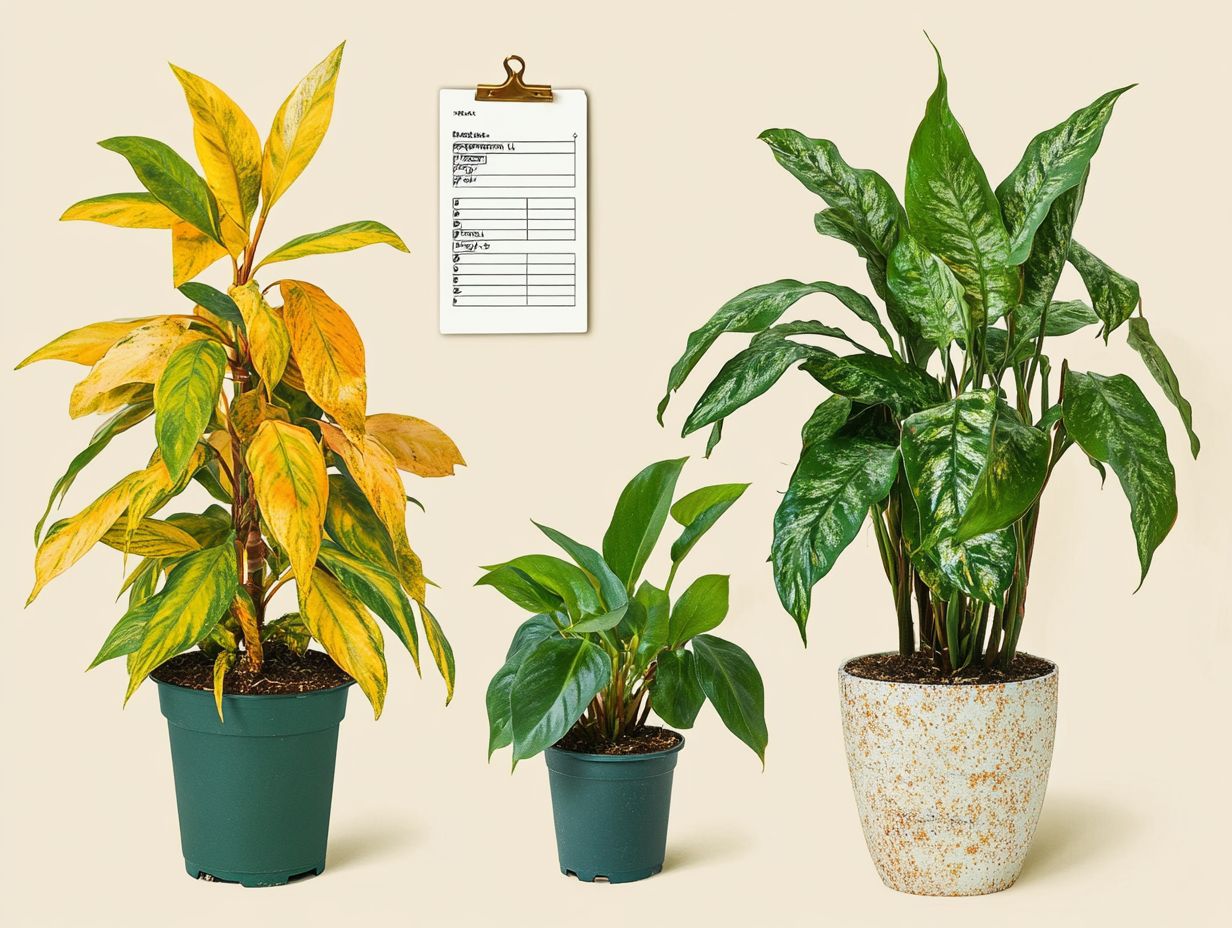
Inadequate light can quickly harm the growth rates and overall vitality of your houseplants. Understanding the specific light requirements of various plant varieties, especially tropical plants, is key to placing them in the best locations.
Knowing these needs not only enables you to provide optimal care but also helps prevent issues like leggy growth or unsightly leaf drop, contributing to better leaf health. Different species have their own preferences; for instance, succulents bask happily in bright, direct sunlight, while ferns thrive in the softer embrace of indirect light paired with higher humidity levels.
To truly assess their needs, think about where each plant grows in nature and the varying light conditions in your home. Morning sun is typically gentle, while afternoon rays can be harsh. Rotate your plants periodically to help balance their exposure, fostering more uniform and lush growth.
5. Overfertilizing
Overfertilizing is a common pitfall that can lead to toxic buildup in the soil, resulting in issues like yellowing leaves and compromised plant health. Your careful attention to plant care is essential for creating optimal growth conditions.
Recognizing the signs of excess fertilizer is crucial for any plant enthusiast. You might notice that your plants display discolored foliage and can suffer from root burn, which occurs when roots are too exposed to fertilizer and severely stunts their growth.
To prevent these complications, it s vital to understand the specific fertilizer needs of each houseplant, as different species have unique requirements. Regular soil testing can provide valuable insights into nutrient levels, enabling you to make informed adjustments to your fertilization routine.
In general, most houseplants flourish with monthly feedings during the growing season, but some may thrive on less. By closely monitoring these needs, you can ensure your plants remain vibrant and healthy while sidestepping the pitfalls of overfertilization.
How to Properly Care for Houseplants
Proper care for your houseplants requires a keen understanding of their unique needs, including optimal humidity levels, appropriate watering techniques, and the specific environmental conditions that foster longevity and vibrant health.
As you navigate these demands, consider additional factors such as fertilization schedules, which provide critical nutrients, and effective pest control methods to safeguard your plants against unwanted pests.
Learn from experts like Rachel Tenney and Kevin Espiritu, who offer practical advice for plant care, along with others like Ashley Anita, Abi Bloom, and John Clements, as well as reputable platforms like Epic Gardening and Miracle-Gro.
These sources deliver invaluable tips, tutorials, and community support, transforming your plant care journey into a more enriching and enjoyable experience. By consistently educating yourself on these practices, you’ll enhance your plants’ vitality and deepen your connection with your green companions.
What Are the Signs of Overwatering and Underwatering?
Recognizing the signs of overwatering and underwatering is essential for maintaining the health of your houseplants. Symptoms like yellowing leaves and wilting can signal moisture levels that need your immediate attention.
Take jade plants; they often reveal overwatering through mushy stems and leaf drop. On the other hand, ferns droop significantly when they re thirsty. A simple touch of the soil can provide valuable insight; if it feels soggy, that s your cue to cut back on watering.
Conversely, underwatering may manifest as crispy leaf edges in peace lilies, while spider plants might flaunt brown tips as a cry for help. To recalibrate your care routine, check the pot’s drainage and tailor your watering schedule to meet the specific care requirements of each plant. Avoiding the top 7 mistakes in watering indoor plants will help restore balance and foster healthy growth.
How Can One Ensure Proper Drainage for Houseplants?
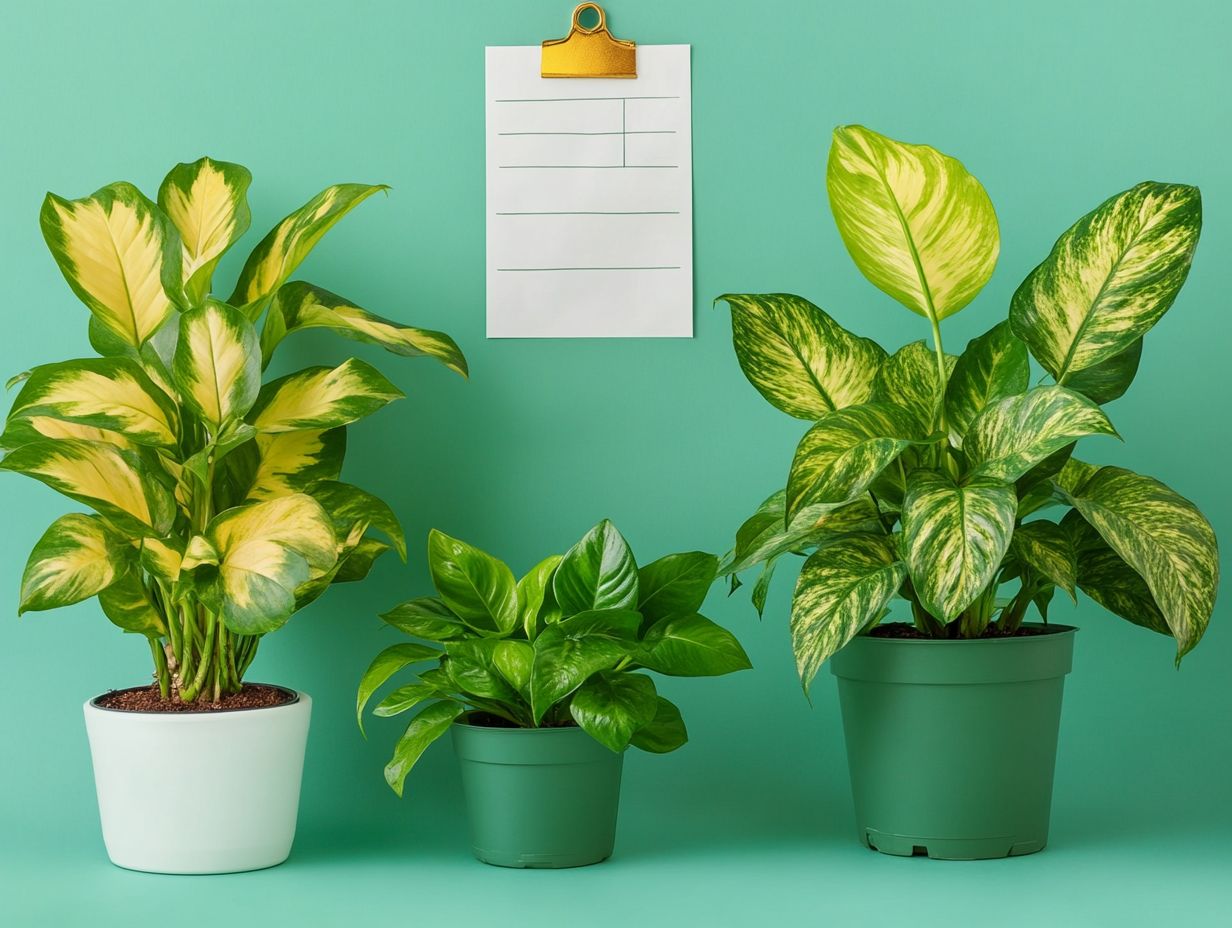
Proper drainage for houseplants is crucial to prevent root rot. It also encourages robust growth.
The type of pots you choose influences moisture escape. Materials like terracotta or ceramic enhance airflow around the roots.
Assessing drainage in existing setups is easy. Check how wet the soil is; if it s consistently wet, consider moving your plant to a new pot.
Elevating your pots slightly can create space for water to escape, enhancing ventilation and boosting your plants’ overall health.
What Types of Light Do Houseplants Need?
Each houseplant has its unique light needs. Understand what your tropical beauties require to flourish.
Low-light plants like snake plants love cozy corners. Medium-light plants like spider plants thrive near east-facing windows, soaking up just the right amount of morning sun.
Bright light lovers, such as succulents and cacti, enjoy windowsills where they can bask in sunlight all day long.
Your green companions will thrive with the right light! Tap into valuable resources like the American Horticultural Society’s guidelines or local gardening clubs for tailored advice.
How Often Should Houseplants Be Fertilized?
Finding the right fertilizing schedule is vital for your plants health. Too much fertilizer can harm them, while too little can stunt their growth.
For leafy greens like pothos, monthly feedings during their growing season are ideal. In contrast, succulents and cacti typically require less frequent attention perhaps just every couple of months.
Being aware of specific signs can help you identify fertilization issues. If you notice yellowing leaves, it could signal nutrient deficiencies. Meanwhile, burnt leaf tips might indicate over-fertilization.
Start observing your plants today! Adjust your care routine and watch your houseplants thrive.
What Other Factors Can Affect Houseplant Care?
Numerous factors can profoundly impact your houseplant care. Environmental conditions, humidity levels, pest control, and soil aeration are crucial elements, especially for tropical plants with specific needs.
Understanding the specific climate in your home is vital. Fluctuating humidity can lead to problems like leaf droop or mold.
A consistently dry atmosphere can stress your plants, leading to yellowed leaves or stunted growth. Act quickly to address pest problems; spider mites and aphids can quickly damage your plants.
To cultivate a nurturing environment, you should consider plant aesthetics as well:
- Monitor humidity levels using a hygrometer to maintain healthy moisture levels.
- Employ insecticidal soap or neem oil as a preventative measure against infestations.
Ensuring proper soil aeration is essential to protect your plant roots. This promotes vigorous growth and overall vitality, which is crucial for plant survival.
Watch this video to learn more about houseplant care tips.
Frequently Asked Questions
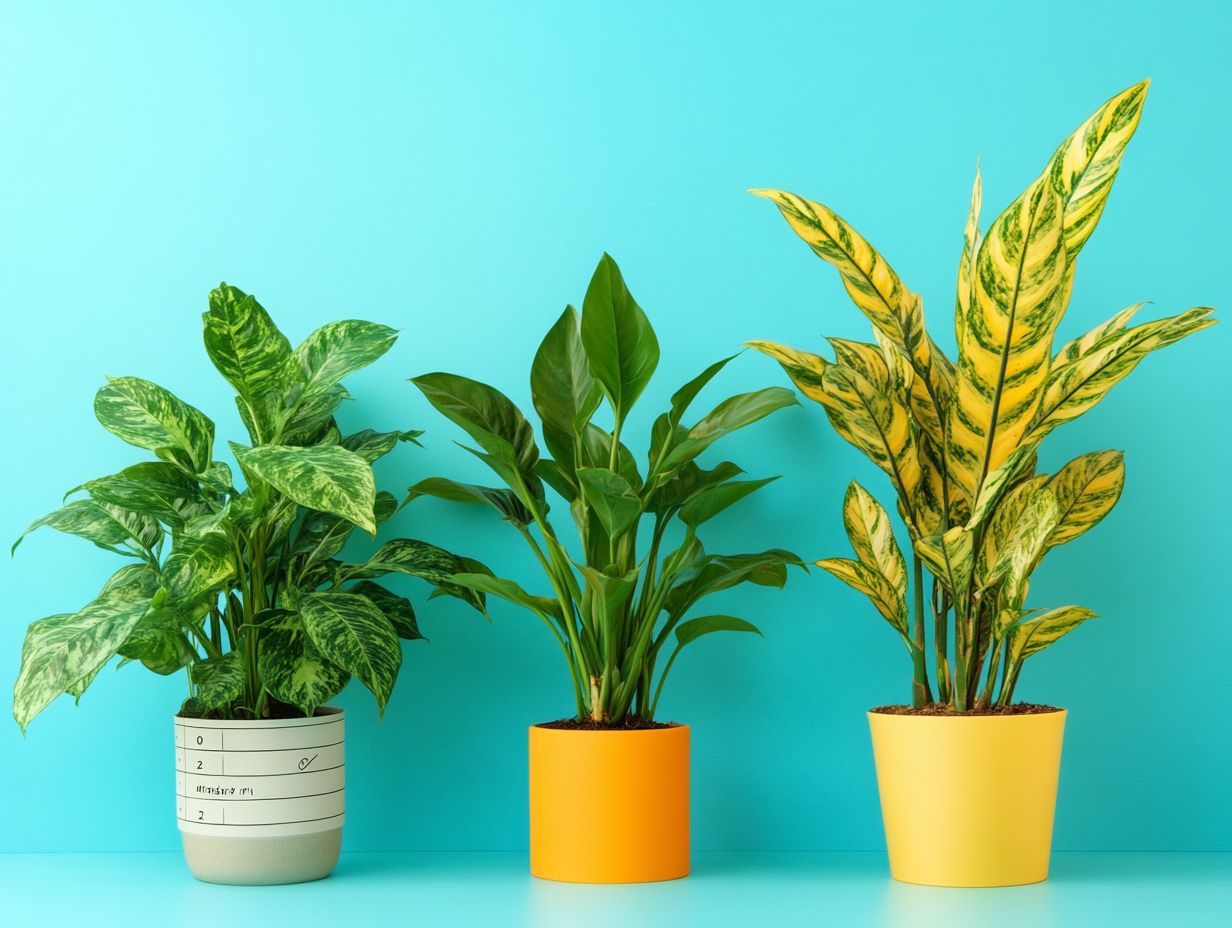
What are the 5 common mistakes in houseplant care?
The 5 common mistakes in houseplant care are overwatering, underwatering, lack of sunlight, using the wrong type of potting mix, and not repotting as needed. These can all affect plant health.
How does overwatering affect houseplants?
Overwatering can lead to root rot, which occurs when plants sit in waterlogged soil, leading to decay. It can cause the plant to wilt and eventually die, creating a breeding ground for pests and fungal diseases.
What happens if houseplants are not getting enough sunlight?
If houseplants are not getting enough sunlight, they may become leggy and have weak stems. They also may not produce enough flowers or fruit, which can be a common mistake made by plant enthusiasts.
Why is using the right type of soil important for houseplants?
Using the right type of soil is important for houseplants because it provides necessary nutrients and helps with proper drainage. Using the wrong type of potting mix can lead to root rot or nutrient deficiencies, posing challenges for plant influencers who share gardening content.
When should houseplants be repotted?
Houseplants should be repotted when they become rootbound, meaning their roots have outgrown their current container. Signs include roots growing out of the drainage holes or the plant becoming top-heavy, which is critical for ensuring healthy growth conditions.
What are some signs of underwatering in houseplants?
Some signs of underwatering include droopy leaves and brown edges on leaves. Soil pulling away from the sides of the pot can also affect overall leaf health, making the plant look wilted and dry.


